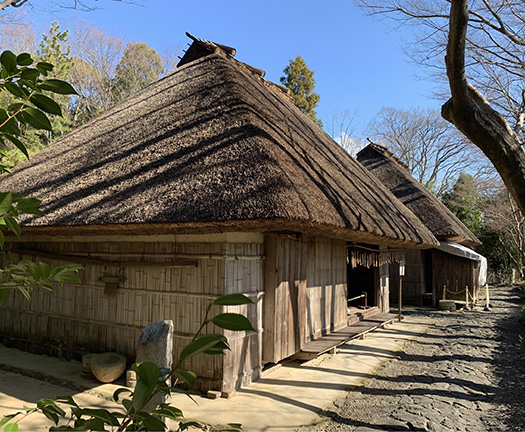


四国の秘境と言われる祖谷のかずら橋近くの家。
古民家を見て来て、大体室内作業空間として土間は普遍的と思っていたけれど
この家ではなんと土間がないのですね。
説明書きでも「四国には珍しく囲炉裏が各室にある」みたいな記述なのですが、
それは煮炊きを考えればそれこそ沖縄でも囲炉裏はある。
それよりも土間がないという方が解明が必要だと考えるけれど、
そういった説明、腑に落ちる解釈はWEB上をチェックする範囲では見られなかった。
以下は見学してのわたしの実感です。
写真は13.5坪の主屋の様子です。
方位的にはたぶん南面する開口部方向から出入りしている様子がわかる。
山間住宅なので、生活利便性を考えて通常生活装置としては
等高線に沿って「斜面にしがみつく」ように諸機能が配置されるものと思える。
間取り図も説明にはないのですが、単純に2間が取られている。
上の写真が主室の「オモテ」のようで下の写真は「ウチ」と思われます。
山間なのでなんといっても平面積の確保が最大の困難。
この13.5坪の主要生活面積を除いて、土間を確保するまでには至らなかったのか。
暮らし方として広い平野部の住宅では農作業が基本と考えられるけれど、
そういった広い農地は確保できないので広大な土間は必要でもなかったのか。
土間は雨天時、また薄暮時、夜間などに農事の準備整理作業が第一の要素。
その延長で炊事作業などのスペースともなった。
この山間の祖谷ではこういった農家古民家の生活要素が欠落していたのか。
たしかに余剰農産品を出荷して生計を営むという基本ライフスタイルとは異なる。
しかしそうであれば、どのような「生計」であったか、が不明。
残念ながら、現状の公開された住宅の情報からはその点がない。
平家の落人の末裔たちはどのように現代に至るまでの暮らしを営んで来れたのか?
想像では土間の代わりは建物の前面室外空間だったのではと思う。

作業平面として一定の広さを確保することが困難なので
この前面の空間が露天のままで作業空間になっていた可能性が高い。
四国は年間の降雨量が少なく、中国で最新土木技術を学んだ空海が
人造の貯水槽・満濃池の土木を指揮したという歴史事実もある。
また四国では「義倉」という日照りからの食糧不足への対応の社会的工夫も見られる。
雨量不足という気候要素を考え合わせると想像は湧いてくる。
しかしやはりこの山間の落人という政治社会的素因による集落、
その集団がどのように歴史年代を生き抜いてこられたのか、
生業についての情報がなかなか見えてこない。
自給自足生活は可能だったとしても、やはり生産手段は人間生活には不可欠。
ひとつの想像としてはもと武人の集団として野生動物の狩猟であったか。
江戸期商家の家系伝承を持つ人間としては自らの想像力不足を思わされます。
English version⬇
[Heike deceased house without dirt floor ② Shikoku living space exploration-5]
A house near the Kazura Bridge in Iyanokazura, which is said to be the unexplored region of Shikoku.
When I saw an old folk house, I thought that the dirt floor was universal as an indoor work space.
There is no dirt floor in this house.
Even in the explanation, it is a description like “There is a hearth in each room, which is rare in Shikoku”.
Considering boiling, there is a hearth even in Okinawa.
I think that it is necessary to clarify that there is no dirt floor than that,
I couldn’t find such an explanation or an unspeakable interpretation within the scope of checking on the WEB.
The following is my feeling of visiting.
The photo shows the main building of 13.5 tsubo.
In terms of direction, you can see that it is coming in and out from the direction of the opening facing south.
As it is a mountainous house, it is a normal living device considering the convenience of living.
It seems that the functions are arranged so as to “cling to the slope” along the contour lines.
The floor plan is not in the explanation, but it is simply two floor plans.
The upper photo is like the “front” in the main room, and the lower photo is probably “Uchi”.
Since it is a mountain, it is the most difficult to secure a flat area.
Except for this 13.5 tsubo main living area, wasn’t it enough to secure a dirt floor?
Agricultural work is considered to be the basic way of living in a large plain house,
Wasn’t it necessary to have a vast soil floor because such a large agricultural land could not be secured?
The first factor in the soil is the preparation and arrangement of farming in the rain, at dusk, and at night.
As an extension of that, it also became a space for cooking work.
Was the living element of such an old farmhouse missing in this mountainous Iya?
Certainly, it is different from the basic lifestyle of shipping surplus agricultural products to earn a living.
However, if so, it is unclear what kind of “livelihood” it was.
Unfortunately, there is no such point from the current publicly available housing information.
How did the descendants of the Heike deceased live up to the present day?
I imagine that instead of the dirt floor, it was the front outdoor space of the building.
Because it is difficult to secure a certain area as a work plane
It is highly possible that the space in front of this was an open-air work space.
Shikoku has less annual rainfall, and Kukai, who learned the latest civil engineering technology in China,
There is also a historical fact that he commanded the civil engineering of Manno Pond, an artificial water tank.
In Shikoku, there is also a social device called “Yoshikura” to deal with the food shortage caused by the drought.
Imagination comes to mind when considering the climatic factor of insufficient rainfall.
However, after all, this village due to the political and social predisposition of a mountain deceased,
How the group survived the historical age
It’s hard to see information about my livelihood.
Even if a self-sufficient life is possible, the means of production is still indispensable for human life.
One imagination was the hunting of wild animals as a group of warriors.
As a person with a family tradition of Edo period merchants, it seems that he lacks his imagination.
Posted on 2月 13th, 2022 by 三木 奎吾
Filed under: 住宅マーケティング, 日本社会・文化研究







コメントを投稿
「※誹謗中傷や、悪意のある書き込み、営利目的などのコメントを防ぐために、投稿された全てのコメントは一時的に保留されますのでご了承ください。」
You must be logged in to post a comment.